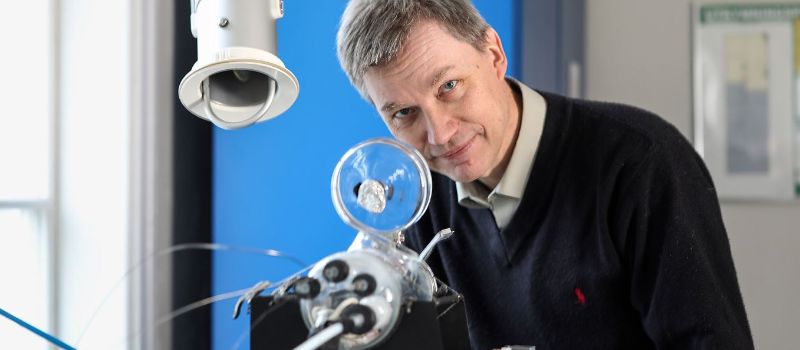Brilliant research
Gränges is using cutting-edge research facilities to investigate tomorrow’s flux-free materials. “It feels great to be a pioneer,” says Torkel Stenqvist, senior brazing expert at Gränges R&I in Finspång.

In May this year, a small team from Gränges Research & Innovation became the first-ever industrial company to book its own research time at the MAX IV laboratory in Lund, Sweden. MAX IV is the world’s newest synchrotron radiation facility, and is equipped with the brightest, highest-quality X-rays in the world.
“Other than academic and medical companies, we are the first to book our own research time at the facility. It feels great to be a pioneer,” says Torkel Stenqvist, senior brazing expert at Gränges R&I, who led the team.
“We are grateful to the funding from Swedish innovation agency Vinnova that partly sponsored this and one other project that is using synchrotron light.”
During the 24-hour beam time at the HIPPIE beamline at MAX IV, the team – including Lars-Åke Näslund, Gränges’ expert in photoelectron spectroscopy, and Ning Wang, a specialist in electron microscopy – conducted several tests on different flux-free materials in operando (under real-life conditions).
“The technique we use is called X-ray Photoelectron Spectroscopy (XPS), which is surface sensitive: basically only about 10 nanometers of the near surface region is examined,” says Stenqvist.
“The brilliance of the X-ray beam enables the use of a gas cell with 1 millibar of nitrogen gas. Although that is a lower pressure than in a real brazing furnace, it is much closer to reality than a laboratory XPS instrument that is always in a high vacuum. The gas cell also allows heating of the sample while measuring XPS and we almost reached the normal brazing temperature.”

In the lab: Torkel Stenqvist at Gränges’ R&I facilities in Finspång.
In the most commonly-used brazing process a flux is used to break up the naturally formed oxide on the material surfaces to be join, but the industry is constantly striving to minimize the use of fluxing agents to reduce costs and to improve the working environment for employees. In flux-free brazing magnesium breaks up the oxide. Without removing the oxide, no metal-to-metal joints can be formed.
“At MAX IV we were able to study the oxide development before the oxide breaks up, and we could observe how magnesium migrates to the top surface and whether it reacts to form an oxide or if it stays as a metal,” says Stenqvist.
Another example that reduces the flux is Gränges’ ground-breaking product TRILLIUM®. But Stenqvist says it’s also important for Gränges to play a leading role in the development of flux-free materials and technologies so the company can stay competitive.
“TRILLIUM® is a fantastic product that puts us in a great position for most applications, but we also need this kind of research to enhance our other existing products. With the knowledge we have acquired at MAX IV and other research facilities, I would say we are at the forefront in this field.”
The research at MAX IV and the analysis of the test results are not all that are on Stenqvist’s and his colleagues’ agenda right now. Gränges R&I has also recently conducted research at the Spring-8 laboratory in Japan and the DESY facility in Hamburg, Germany.
“In this project we try to make precise 3D maps of the grains and how they are orientated, and how this correlates to brazing performance,” says Stenqvist, who will soon be temporarily relocating from Gränges R&I for a two-year secondment to Gränges’ premises in Huntingdon, USA, to help develop its new laboratory.
But out of sight is not out of mind. “I will continue to be involved in these two projects,” he says.
Aluminium brazing facts
Aluminium brazing is carried out at about 600 °C. To form a metal to metal joint with a fine fillet, the naturally formed surface oxide must be removed.
Vacuum brazing (VB) is performed in a vacuum furnace, so no oxygen is present that can oxidise the parts during the heating. There is no flux, and magnesium, often conveniently alloyed into the filler metal, is essential to break up the oxide. The brazed units are very clean after brazing. The downsides of this method are that it is at best semi-continuous and slower due to heating by radiation only, and that it uses a more complicated furnace which also requires extensive maintenance.
Flux brazing involves a flux that flows into the joint to remove oxides on the part, preparing the material for the iquidus filler metal. The filler metal displaces the flux and creates a strong, solid braze joint.
Controlled Atmosphere Brazing (CAB) uses a fluoride flux, and normally it is a continuous process with a tunnel furnace for high productivity. Batch furnaces exist too, at smaller operators. An inert nitrogen gas environment prevents oxidation during heating. The gas atmosphere transports heat to the units by convection, heating them than vacuum brazing. This method was introduced to the industry in the 1980s and is still the dominant process today.
Flux-free brazing combines the magnesium oxide break-up of the vacuum brazing with the Controlled Atmosphere Brazing nitrogen atmosphere. Purer nitrogen than in normal CAB must be used.
(The method Gränges was testing at MAX IV)
Active brazing in CAB. Gränges’ ground-breaking product TRILLIUM® has built-in properties in the metal matrix composite material, which means that a fluxing agent is not required.

 svenska
svenska
 中文(中华人民共和国)
中文(中华人民共和国)



